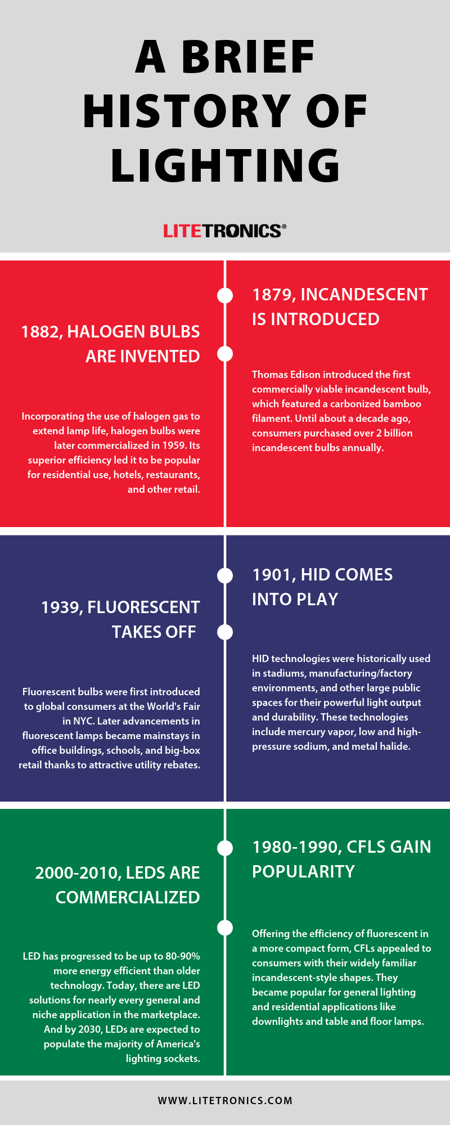A BRIEF HISTORY OF LIGHTING
From incandescent and halogen bulbs to fluorescent, HID, compact fluorescent, and now LED lamps, the lighting industry has experienced a colorful evolution in technology, performance, form, and function over the past 150 years. Here are some of the highlights in the history of lighting:
1. Incandescent is introduced
The first commercially viable incandescent bulb, which featured a carbonized bamboo filament, was introduced by Thomas Edison in 1879. Over 125 years later (until just about a decade ago), global consumers purchased over two billion incandescent bulbs annually.
2. Incandescent Takes a More Efficient Turn with Halogen
Considered a more efficient version of incandescent technology, halogen bulbs incorporate the use of halogen gas to extend lamp life and were invented in 1882 but commercialized in 1959. Based on the natural quality of halogen lighting (which approaches the look and feel of daylight) and its greater efficiency, halogen technology had long been favored for residential use as well as use in jewelry stores, restaurants, hotels, and other retail and hospitality outlets.
3. Lighting Reaches New Heights with HID
High-intensity discharge (HID) technologies such as mercury vapor, low and high-pressure sodium, and metal halide emit light using an electric arc within a small discharge tube. They were historically used in stadiums and other large public arenas as well as in roadway/street lighting and manufacturing/factory settings based on their powerful light output, durability, and relatively long life. While Peter Cooper Hewitt developed the first commercial mercury vapor lamp in 1901, sales of mercury vapor and other HID sources took off commercially in the 1960s.
4. Fluorescent Takes the Commercial Market by Storm
Fluorescent bulbs were first presented to global consumers at the 1939 World’s Fair in New York City. Incorporating a glass discharge tube, these lamps ‘fluoresce,’ or emit light, thanks to a fluorescent coating on the lamp’s interior which reacts to the presence of mercury gas. For some 50 years, lamps were typically sold in 1½-inch-diameter (T12) versions that were powered by magnetic ballasts. Then, smaller, more efficient, and longer-lasting fluorescent lamps (T8 and T5 varieties) driven by electronic ballasts came on the scene in the early 1990s. Driven by attractive utility rebates, these lamps became a mainstay in everything from office buildings to high-ceiling industrial applications, schools, and big-box retail outlets.
5. CFLs Appeal to America’s Eco-Sense
Compact fluorescent lamps (CFLs) were commercialized in the 1980s-1990s and offered the efficiency of fluorescent technology in a more compact form. Highly efficient but offered in more consumer-friendly, incandescent-style shapes that society was familiar with, CFLs enjoyed popularity in general lighting and residential applications like downlights and table and floor lamps.
6. LEDs: The Future of Lighting
Light-emitting diode (LED) technology – a semiconductor light source that emits light when current flows through it – was first popularized for various commercial and residential lighting applications 10-15 years ago. Serving as powerful and directional light sources that channel light exactly where it’s needed, LEDs deliver the benefits of long life, low maintenance, mercury-free operation, and outstanding energy efficiency (up to 80-90% more efficient than older technology). Today, LED options have been introduced for nearly every general and niche lighting application in the marketplace and can replace virtually every other technology that preceded it. According to the DOE, LEDs are expected to populate most U.S. lighting sockets by 2030.
A Tradition of Innovation
As Litetronics approaches its milestone 50th anniversary in 2020, the company’s spirit of innovation has proven as dynamic as the industry itself!
Since its founding in 1970, Illinois-based Litetronics has been dedicated to making lighting easier to install, better-looking, longer-lasting, and more efficient than ever. The company’s tradition of innovation began with its 1972 introduction of the industry’s first 20,000-hour incandescent bulb -- which lasted up to 26 times longer than a standard lamp! -- and didn’t stop there.
Subsequent landmarks would include the company’s entry into the halogen PAR and HID markets in the 1980s and its introduction of the first spiral-shaped CFL to the U.S. in 1995, an iconic form which still remains an industry standard. In 2003, Litetronics introduced its patented Micro-Brite cold cathode fluorescent lamp in a standard bulb shape, followed by the launch of its patented LED Parfection lamp in 2010.
A Bright Future
More recently, Litetronics’ extensive investment in the exciting and rapidly-expanding LED arena have delivered innovation after innovation to the commercial lighting market.
These include the 2014 launch of the company’s patented, easy-to-install LED Retrofit Kits designed to replace linear fluorescent lamps as well as the 2016 introduction of its series of powerful LED High Bay fixtures, which can replace T8/T5 fluorescent and metal halide technology in a broad range of commercial, industrial, and high-ceiling applications. New LED Magnetic Retrofits and LED Light Panels as well as popular niche fixtures such as the LED Garage Light, LED food-safe/NSF High Bay, and LED Hazardous Location High Bay further demonstrate Litetronics’ commitment to serving the broad range of user needs and increasing access to the benefits of LED technology.
Once a “bulb” company during the heyday of incandescent technology, Litetronics has transformed to become a leader in LED technology and one of the industry’s most trusted sources of commercial lighting solutions. As it celebrates its colorful past and bright future, Litetronics remains committed to pushing the boundaries of innovation in the lighting industry.
To learn more about upgrading to LED technology in your facility, contact us today!

